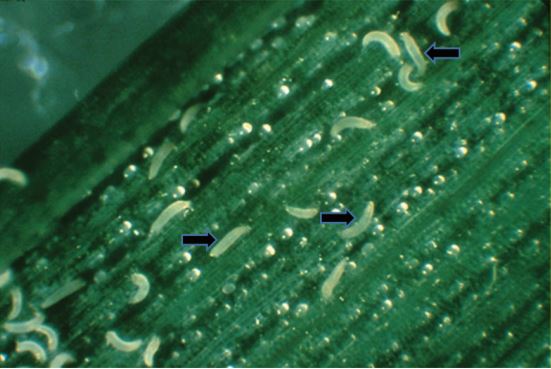Authored by: David Marburger and Bob Hunger
Wheat streak mosaic (WSM) was a significant disease issue for a number of producers in Oklahoma this past year (Figure 1). This disease, caused by wheat streak mosaic virus, is transmitted by the wheat curl mite (Figure 2). This mite can survive from one wheat growing season to the next on a number of different grass species, but primarily on volunteer wheat. Some like to refer to these host weeds or volunteer wheat during the summer fallow period as the “green bridge.” One of the best ways to manage this disease is controlling the wheat curl mite by eliminating the green bridge, and this can be done with tillage or a herbicide application. Since the life span of the wheat curl mite is about two weeks, volunteer wheat needs to be dead (i.e., no green tissue) for at least two weeks prior to the emergence of the newly planted wheat crop. If you spray glyphosate two weeks prior to emergence of the new wheat crop, for example, this will likely not control the wheat curl mite as the volunteer wheat will not be dead (no green tissue) for that minimum two week period.

Figure 1. Symptoms of wheat streak mosaic.

Figure 2. Wheat curl mites on a leaf surface at approximately 30-40x magnification. Source: Texas A&M.
With the current wheat prices, rain that has fallen, and rain in the forecast (trying not to jinx it here), producers especially in southern Oklahoma are going to be ready to plant by the end of August into early September to target more fall forage. In that scenario, volunteer wheat needs to be controlled right now in order to have that plant tissue dead for the minimum two week period prior to the emergence of the new wheat crop. For producers who will be planting a little later than this, there is a little bigger window for controlling that volunteer wheat yet, but it is something to keep at the top of your to-do list.
More information on wheat streak mosaic and wheat curl mites can be found in the OSU Fact Sheet EPP-7328 Three Virus Diseases of Oklahoma.